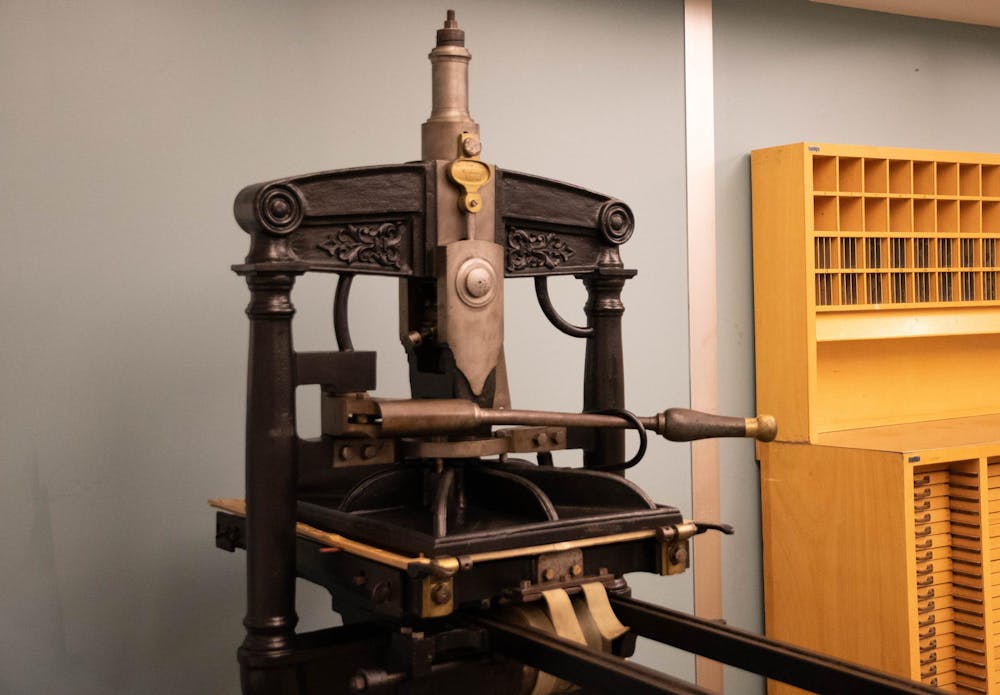As early as spring 2024, a newly installed historic printing press at Davis Library will be available for students to experience a hands-on learning opportunity.
The hand-operated device, currently blocked off by dividers, can be found on the library’s first floor just past its digital printing and scanner stations. Manufactured in Milan, Italy and installed on campus on Nov. 6, the 1884 Luigi Ghisi Albion press is one of two presses obtained by UNC through a donation by the Peterson family.
Both now have a permanent home at UNC.
The second donated machine, an 1847 R. Hoe Washington press, is located at the UNC Press office. Elizabeth Ott, the interim associate librarian for special collections and director of Wilson Library, said library staff were offered a choice between the two. The Albion press closely resembles the widely used book printing technology adopted to produce most books after 1450.
“The Albion has a few more decorative elements than the Washington press. So it is nice to look at, although I won't say that that's quite the reason. It's in wonderful working condition,” Ott said.
Ott said library staff began communication with donors Chris and Eric Peterson in 2019 after the pair inherited printing equipment from their father’s printing company, Huckleberry Press. She said the two brothers were initially unsure about what to do with the equipment but sought to “see their father’s legacy extended.”
Ott said she and other library staff were excited when the Petersons offered to donate the two presses to UNC. She compared the educational opportunity to spaces such as UNC’s BeAM Makerspaces and Digital Media Lab — campus sites where students can learn through hands-on involvement.
“We thought this would be a great way for us to create another opportunity for students to learn about how books were printed in the past,” she said.
Ott said both presses have a long history of use for library book printing. With training and staff supervision, she said students will be able to try the Albion during educational demonstrations with their classes to receive an up-close look at the press’s operation and to bring home their own printed writing.
Beth Grabowski, a distinguished professor of art, said students may be interested in exploring the letterpress’s history or creating poetry with it.
Both presses are platen presses, which use a clamping process on two planes to print ink on paper. This style has been used in the West since Johannes Gutenberg invented the printing press in the 15th century, Ott said, which introduced letterpress printing to Europe.
Ott also said later innovation in the printing industry in the 19th century allowed for the creation of iron printing presses — such as the two donated to UNC — which have a “more petite” footprint and toggle mechanism that allows easier use than their earlier wooden counterparts.
“Presses like this really revolutionized and democratized printing in a lot of ways because lots of different kinds of people could use them,” Ott said.
Grabowski, who works with the third and last printing press on campus — an 1889 Albion press that Hanes Art Center has housed for years — said the uses of presses can be limited.
“It's very hard for people not in the program to get art classes here, so it's nice that there's another opportunity for people to pursue learning about things like this,” Grabowski said.
Anna-Katherine Grubb, a current English and political science double major at UNC, said she is familiar with UNC’s experimental learning spaces but has not found a reason to utilize them regularly. However, she said she can imagine how the opportunity to print and share pieces of writing would have complemented her experience in a seminar-style creative nonfiction class she previously took.
“I think that could really inspire people who maybe wanted to get into publishing or even editing or any kind of writing career," she said. "I think it could be valuable."
Ott said she hopes the new installation will allow students to become interested in the history of book printing and encourage further exploration of UNC’s library collection. She also said the library staff hopes to develop a mechanism for students to sign up to use the printing press with their instructors in the spring.
“The best part of my job is seeing students learn and get excited about the things that we have,” she said.



